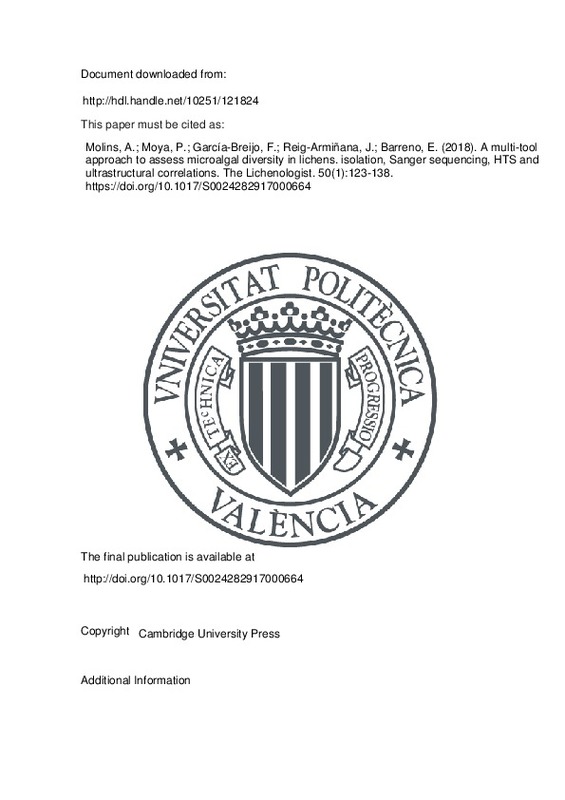Molins, A.; Moya, P.; García-Breijo, F.; Reig-Armiñana, J.; Barreno, E. (2018). A multi-tool approach to assess microalgal diversity in lichens. isolation, Sanger sequencing, HTS and ultrastructural correlations. The Lichenologist. 50(1):123-138. https://doi.org/10.1017/S0024282917000664
Por favor, use este identificador para citar o enlazar este ítem: http://hdl.handle.net/10251/121824
|
Título:
|
A multi-tool approach to assess microalgal diversity in lichens. isolation, Sanger sequencing, HTS and ultrastructural correlations
|
|
Autor:
|
Molins, Arantxa
Moya, P.

 García-Breijo, Francisco-José
Reig-Armiñana, José
Barreno, Eva
García-Breijo, Francisco-José
Reig-Armiñana, José
Barreno, Eva
|
|
Entidad UPV:
|
Universitat Politècnica de València. Departamento de Ecosistemas Agroforestales - Departament d'Ecosistemes Agroforestals
|
|
Fecha difusión:
|
|
|
Resumen:
|
[EN] Lichen thalli represent the most conspicuous examples of fungal-algal interactions. Studies that describe phycobiont diversity within entire thalli are based mainly on Sanger sequencing. In some lichen species, this ...[+]
[EN] Lichen thalli represent the most conspicuous examples of fungal-algal interactions. Studies that describe phycobiont diversity within entire thalli are based mainly on Sanger sequencing. In some lichen species, this technique could underestimate the intrathalline coexistence of multiple microalgae. In this study different multi-tool approaches were applied to two lichen taxa, Circinaria hispida and Flavoparmelia soredians, to detect algal coexistence. Here, we combined Sanger sequencing, a specific polymerase chain reaction (PCR) primer, 454-pyrosequencing, phycobiont isolation and ultrastructural characterization. Furthermore, we compared pyrenoid ultrastructural features of lichenized phycobionts with microalgae isolated in culture. An improved methodology was used to isolate and propagate phycobionts which, in combination with fast genetic identification, resulted in a considerable reduction in time and cost to complete the process. This isolation method, coupled with a specific PCR primer, allowed for the detection of coexisting algae in C. hispida (four Trebouxia lineages). 454-pyrosequencing detected only a fraction of such diversity, while Sanger sequencing identified only the primary phycobiont. Ultrastructural features of the isolated algae were observed by transmission electron microscopy; the maintenance of the pyrenoid characteristics suggested the existence of different Trebouxia lineages. In F. soredians a single Trebouxia lineage was identified using all these approaches.
In cases of lichens with algal coexistence, a combination of different molecular and ultrastructural approaches may be required to reveal the underlying algal diversity within a single thallus. The approach proposed in this study provides information about the relationship between molecular and ultrastructural data, and represents an improvement in the delimitation of taxonomic features which is needed to recognize intrathalline Trebouxia diversity.
[-]
|
|
Palabras clave:
|
Coexistence
,
Propagation
,
454-pyrosequencing
,
Trebouxia
|
|
Derechos de uso:
|
Reserva de todos los derechos
|
|
Fuente:
|
The Lichenologist. (issn:
0024-2829
)
|
|
DOI:
|
10.1017/S0024282917000664
|
|
Editorial:
|
Cambridge University Press
|
|
Versión del editor:
|
http://doi.org/10.1017/S0024282917000664
|
|
Código del Proyecto:
|
info:eu-repo/grantAgreement/GVA//PROMETEOII%2F2013%2F021/ES/Genoma de Trebouxia sp. TR9 como modelo de alga verde simbionte: caracterización, potencial metabólico y estructural. Implicaciones de la coexistencia con otros simbiontes en talos liquénicos y plantas soporte/
info:eu-repo/grantAgreement/MINECO//CGL2016-79158-P/ES/NUEVA PERSPECTIVA INTERDISCIPLINAR SOBRE LA COMPLEJIDAD DE LAS SIMBIOSIS LIQUENICAS: ESTUDIO GENOMICO Y FUNCIONAL DE MICROALGAS Y BACTERIAS/
info:eu-repo/grantAgreement/GVA//PROMETEO%2F2017%2F039/ES/La simbiosis liquénica como asociación mutualista compleja, paradigma de resiliencia en ambientes adversos. Diversidad genómica, estructural y funcional/
|
|
Agradecimientos:
|
Supported by the Ministerio de Economia y Competitividad (MINECO, Spain) (CGL2016-79158-P) and Excellence in Research (Generalitat Valenciana, Spain) (PROMETEOII/2013/021 and PROMETEO/2017/039). We wish to thank the ...[+]
Supported by the Ministerio de Economia y Competitividad (MINECO, Spain) (CGL2016-79158-P) and Excellence in Research (Generalitat Valenciana, Spain) (PROMETEOII/2013/021 and PROMETEO/2017/039). We wish to thank the technicians (Maria Teresa Minguez and Nuria Cebrian) of the Servicio de Microscopia Electronica, SCSIE and Jardi Botanic (Universitat de Valencia) who helped us to perform the TEM process, and Santiago Catala for the pyrosequencing analyses. Daniel Sheerin revised the English manuscript.
[-]
|
|
Tipo:
|
Artículo
|







![[Cerrado]](/themes/UPV/images/candado.png)


